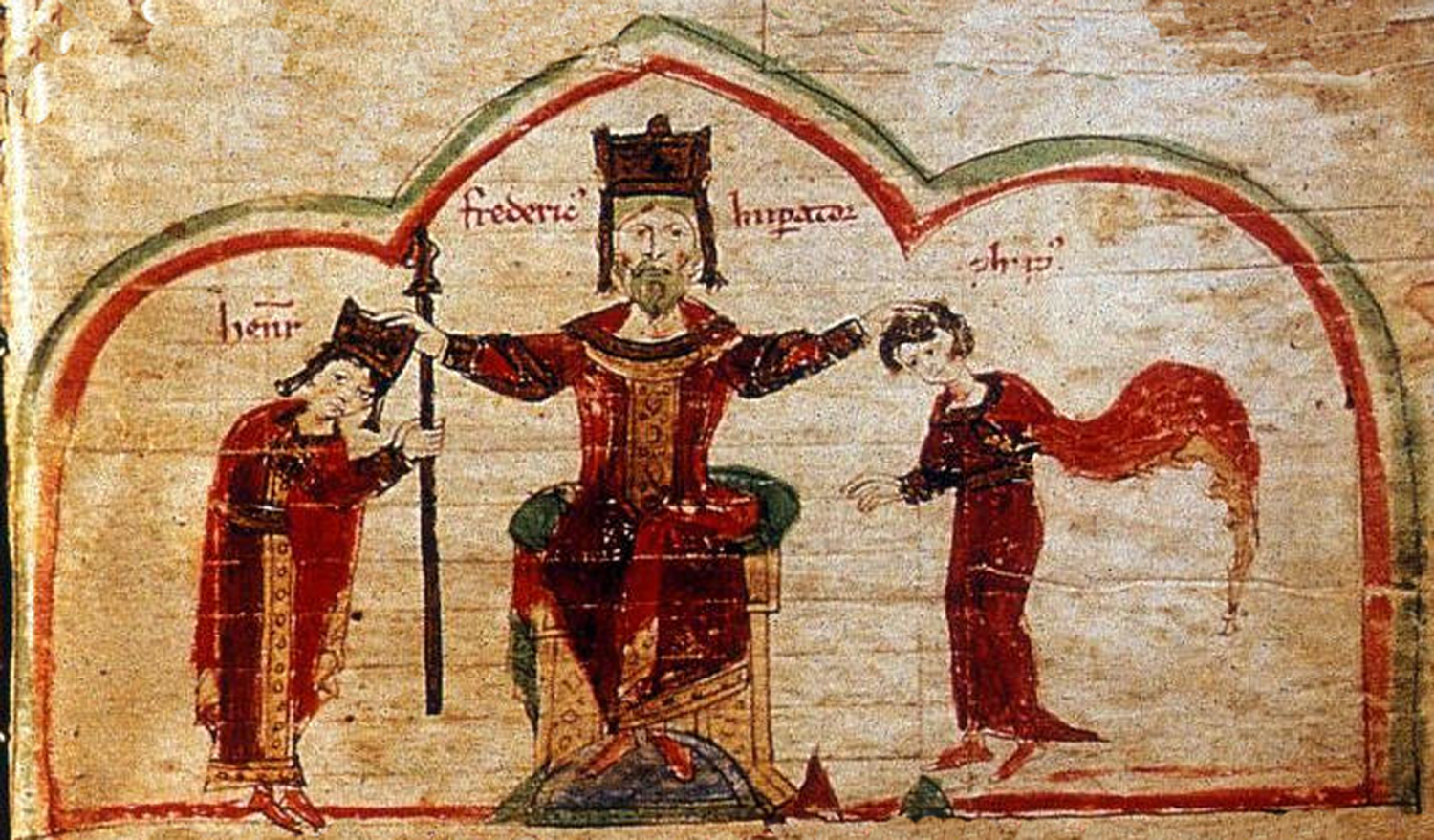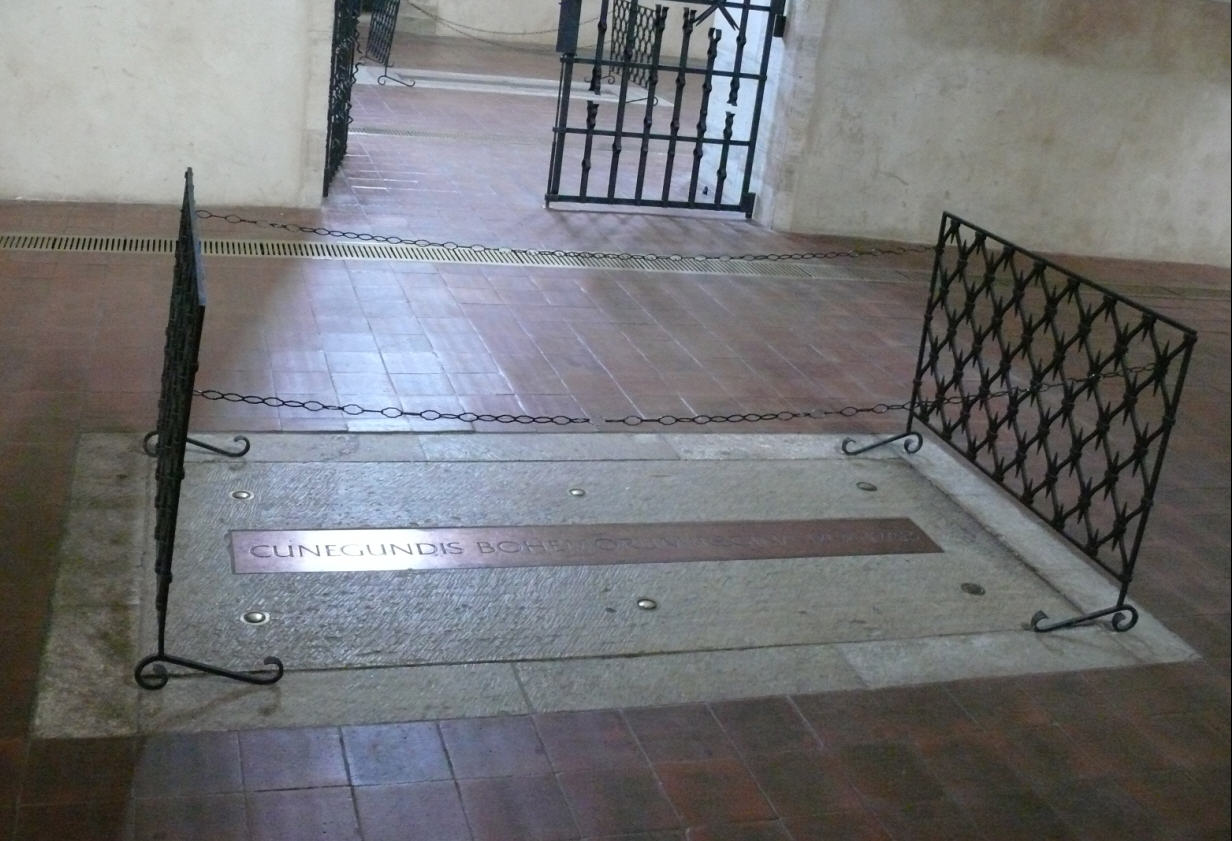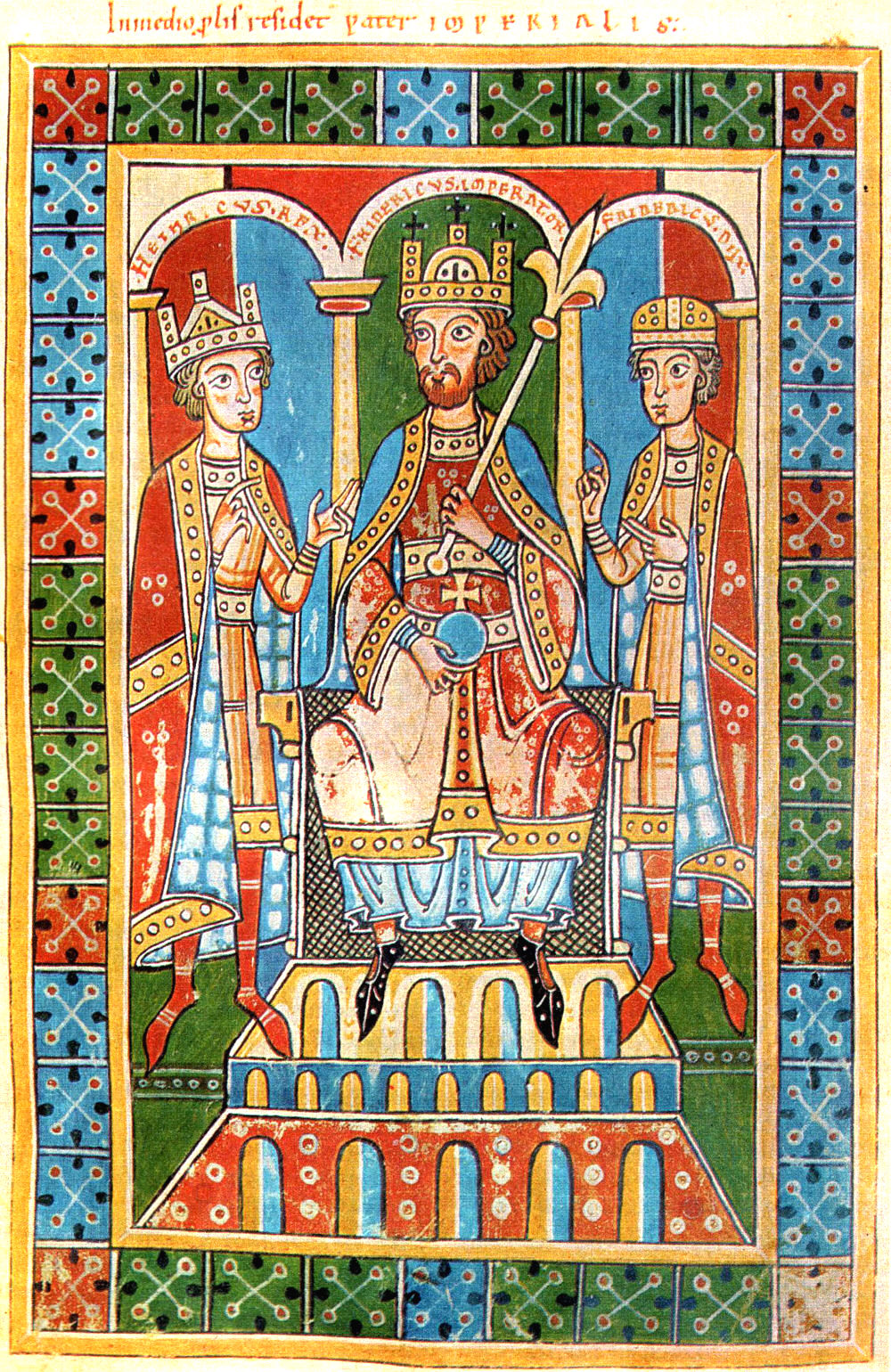|
Philip Of Germany
Philip of Swabia (February/March 1177 – 21 June 1208) was a member of the House of Hohenstaufen and King of Germany from 1198 until his assassination. The death of his older brother Emperor Henry VI in 1197 meant that the Hohenstaufen rule (which reached as far as the Kingdom of Sicily) collapsed in imperial Italy and created a power vacuum to the north of the Alps. Reservations about the kingship of Henry VI's underage son, Frederick, led to two royal elections in 1198, which resulted in the German throne dispute: the two elected kings Philip of Swabia and the Welf Otto of Brunswick, claimed the throne for themselves. Both opponents tried in the following years through European and papal support, with the help of money and gifts, through demonstrative public appearances and rituals, to decide the conflict for oneself by raising ranks or by military and diplomatic measures. Philip was able to increasingly assert his kingship against Otto in the north part of the Alps. However, ... [...More Info...] [...Related Items...] OR: [Wikipedia] [Google] [Baidu] |
Imperial Regalia
The Imperial Regalia, also called Imperial Insignia (in German ''Reichskleinodien'', ''Reichsinsignien'' or ''Reichsschatz''), are regalia of the Holy Roman Emperor. The most important parts are the Crown, the Imperial orb, the Imperial sceptre, the Holy Lance and the Imperial Sword. Today they are kept at the Imperial Treasury in the Hofburg palace in Vienna, Austria. The Imperial Regalia are the only completely preserved regalia from the Middle Ages. During the late Middle Ages, the word Imperial Regalia (Reichskleinodien) had many variations in the Latin language. The regalia were named in Latin: ''insignia imperialia, regalia insignia, insignia imperalis capellae quae regalia dicuntur'' and other similar words. Components The regalia is composed of two different parts. The greater group are the so-called Nürnberger Kleinodien (roughly translated ''Nuremberg jewels''), named after the town of Nuremberg, where the regalia were kept from 1424 to 1796. This part comprise ... [...More Info...] [...Related Items...] OR: [Wikipedia] [Google] [Baidu] |
Kunigunde Of Hohenstaufen
Kunigunde of Hohenstaufen or Kunigunde of Swabia (german: Kunigunde von Staufen or Kunigunde von Schwaben, cz, Kunhuta Štaufská or Kunhuta Švábská) (February/March 1202 – 13 September 1248) was the third daughter of Philip, Duke of Swabia and his wife, Irene Angelina. Family She and her three sisters were orphaned in 1208; that year, her father was murdered, and a few months later her mother died following the birth of a fifth daughter, who did not live either. Marriage and children Kunigunde soon moved to Prague, where her fiancé Wenceslaus lived. He was the eldest surviving son of Ottokar I of Bohemia and his second wife Constance of Hungary. In 1224, Kunigunde married Wenceslaus. They were crowned in 1228. In 1230, Wenceslaus succeeded his father as King of Bohemia, with Kunigunde as his queen consort. However, Queen Kunigunde seems to be not important in politics, although she founded many monasteries. They had: *Vladislaus III of Moravia (c. 1228 – 3 January 12 ... [...More Info...] [...Related Items...] OR: [Wikipedia] [Google] [Baidu] |
German Throne Dispute
The German throne dispute or German throne controversy (german: Deutscher Thronstreit) was a political conflict in the Holy Roman Empire from 1198 to 1215. This dispute between the House of Hohenstaufen and House of Welf was over the successor to Emperor Henry VI who had just died. After a conflict lasting 17 years the Hohenstaufen Frederick II prevailed. Origin On 28 September 1197, Emperor Henry VI, who was just 32 years old, died unexpectedly creating unrest in the circles of the princes about the future direction of the Empire. There were now opposing forces to the hitherto stable position of the Hohenstaufens, as had already been demonstrated by the failure of the Henry VI's '' Erbreichsplan'' or "plan for hereditary succession". The princes were now faced with the question as to whether they would recognize Henry's son, Frederick II, now only three years old, as successor. Although Frederick had already been elected at the end of 1196 in Frankfurt under the heavy influe ... [...More Info...] [...Related Items...] OR: [Wikipedia] [Google] [Baidu] |
Alps
The Alps () ; german: Alpen ; it, Alpi ; rm, Alps ; sl, Alpe . are the highest and most extensive mountain range system that lies entirely in Europe, stretching approximately across seven Alpine countries (from west to east): France, Switzerland, Italy, Liechtenstein, Austria, Germany, and Slovenia. The Alpine arch generally extends from Nice on the western Mediterranean to Trieste on the Adriatic and Vienna at the beginning of the Pannonian Basin. The mountains were formed over tens of millions of years as the African and Eurasian tectonic plates collided. Extreme shortening caused by the event resulted in marine sedimentary rocks rising by thrusting and folding into high mountain peaks such as Mont Blanc and the Matterhorn. Mont Blanc spans the French–Italian border, and at is the highest mountain in the Alps. The Alpine region area contains 128 peaks higher than . The altitude and size of the range affect the climate in Europe; in the mountains, precipitation ... [...More Info...] [...Related Items...] OR: [Wikipedia] [Google] [Baidu] |
Kingdom Of Sicily
The Kingdom of Sicily ( la, Regnum Siciliae; it, Regno di Sicilia; scn, Regnu di Sicilia) was a state that existed in the south of the Italian Peninsula and for a time the region of Ifriqiya from its founding by Roger II of Sicily in 1130 until 1816. It was a successor state of the County of Sicily, which had been founded in 1071 during the Norman conquest of the southern peninsula. The island was divided into three regions: Val di Mazara, Val Demone and Val di Noto. In 1282, a revolt against Angevin rule, known as the Sicilian Vespers, threw off Charles of Anjou's rule of the island of Sicily. The Angevins managed to maintain control in the mainland part of the kingdom, which became a separate entity also styled ''Kingdom of Sicily'', although it is commonly referred to as the Kingdom of Naples, after its capital. From 1282 to 1409 the island was ruled by the Spanish Crown of Aragon as an independent kingdom, then it was added permanently to the Crown. After 1302, the isl ... [...More Info...] [...Related Items...] OR: [Wikipedia] [Google] [Baidu] |
Emperor Henry VI
Henry VI (German: ''Heinrich VI.''; November 1165 – 28 September 1197), a member of the Hohenstaufen dynasty, was King of Germany (King of the Romans) from 1169 and Holy Roman Emperor from 1191 until his death. From 1194 he was also King of Sicily. Henry was the second son of Emperor Frederick Barbarossa and Beatrice I, Countess of Burgundy. Well educated in the Latin language, as well as Roman and canon law, Henry was also a patron of poets and a skilled poet himself. In 1186 he was married to Constance of Sicily, the posthumous daughter of the Norman king Roger II of Sicily. Henry, stuck in the Hohenstaufen conflict with the House of Welf until 1194, had to enforce the inheritance claims by his wife against her nephew Count Tancred of Lecce. Henry's attempt to conquer the Kingdom of Sicily failed at the siege of Naples in 1191 due to an epidemic, with Empress Constance captured. Based on an enormous ransom for the release and submission of King Richard I of England, he conqu ... [...More Info...] [...Related Items...] OR: [Wikipedia] [Google] [Baidu] |
King Of Germany
This is a list of monarchs who ruled over East Francia, and the Kingdom of Germany (''Regnum Teutonicum''), from the division of the Frankish Empire in 843 and the collapse of the Holy Roman Empire in 1806 until the collapse of the German Empire in 1918. Note on titles #The Kingdom of Germany started out as the eastern section of the Frankish kingdom, which was split by the Treaty of Verdun in 843. The rulers of the eastern area thus called themselves ''rex'' ''Francorum'' ("king of the Franks"), ''rex Francorum orientalium'' ("king of the East Franks"), and later just ''rex''. A reference to the "Germans", indicating the emergence of a German nation of some sort, did not appear until the eleventh century, when the pope referred to his enemy Henry IV as ''rex teutonicorum'', king of the Germans, in order to brand him as a foreigner. The kings reacted by consistently using the title ''rex Romanorum'', king of the Romans, to emphasize their universal rule even before becoming emp ... [...More Info...] [...Related Items...] OR: [Wikipedia] [Google] [Baidu] |
Catholic Church
The Catholic Church, also known as the Roman Catholic Church, is the largest Christian church, with 1.3 billion baptized Catholics worldwide . It is among the world's oldest and largest international institutions, and has played a prominent role in the history and development of Western civilization.O'Collins, p. v (preface). The church consists of 24 ''sui iuris'' churches, including the Latin Church and 23 Eastern Catholic Churches, which comprise almost 3,500 dioceses and eparchies located around the world. The pope, who is the bishop of Rome, is the chief pastor of the church. The bishopric of Rome, known as the Holy See, is the central governing authority of the church. The administrative body of the Holy See, the Roman Curia, has its principal offices in Vatican City, a small enclave of the Italian city of Rome, of which the pope is head of state. The core beliefs of Catholicism are found in the Nicene Creed. The Catholic Church teaches that it is the on ... [...More Info...] [...Related Items...] OR: [Wikipedia] [Google] [Baidu] |
Speyer Cathedral
, native_name_lang = German , image = Speyer_dom_11.jpg , imagesize = 280px , imagelink = , imagealt = , landscape = , caption = , pushpin map = , pushpin label position = , pushpin map alt = , pushpin mapsize = , relief = , map caption = , coordinates = , osgraw = , osgridref = , location = Speyer , country = Germany , denomination = Roman Catholic , previous denomination = , churchmanship = , membership = , attendance = , website Website of the Cathedral , former name = , bull date = , founded date = 1030 , founder = Conrad II , dedication = , dedicated date = , consecrated date = ... [...More Info...] [...Related Items...] OR: [Wikipedia] [Google] [Baidu] |
Kingdom Of Germany
The Kingdom of Germany or German Kingdom ( la, regnum Teutonicorum "kingdom of the Germans", "German kingdom", "kingdom of Germany") was the mostly Germanic-speaking East Frankish kingdom, which was formed by the Treaty of Verdun in 843, especially after the kingship passed from Frankish kings to the Saxon Ottonian dynasty in 919. The king was elected, initially by the rulers of the stem duchies, who generally chose one of their own. After 962, when Otto I was crowned emperor, East Francia formed the bulk of the Holy Roman Empire, which also included the Kingdom of Italy and, after 1032, the Kingdom of Burgundy. Like medieval England and medieval France, medieval Germany consolidated from a conglomerate of smaller tribes, nations or polities by the High Middle Ages. The term ''rex teutonicorum'' (" king of the Germans") first came into use in Italy around the year 1000. It was popularized by the chancery of Pope Gregory VII during the Investiture Controversy (late 11th centur ... [...More Info...] [...Related Items...] OR: [Wikipedia] [Google] [Baidu] |
Duchy Of Franconia
The Duchy of Franconia (german: Herzogtum Franken) was one of the five stem duchies of East Francia and the medieval Kingdom of Germany emerging in the early 10th century. The word Franconia, first used in a Latin charter of 1053, was applied like the words Francia, France, and '' Franken'', to a portion of the land occupied by the Franks. Geography It stretched along the valley of the River Main from its confluence with the Upper Rhine up to the Bavarian March of the Nordgau, in the areas of the present-day Bavarian region of Franconia, the adjacent southern parts of the Free State of Thuringia, northern Baden-Württemberg (i.e. Rhine-Neckar and Heilbronn-Franken) and Hesse. It also included several ''Gaue'' on the left bank of the Rhine around the cities of Mainz, Speyer and Worms comprising present-day Rhenish Hesse and the Palatinate region. Located in the centre of what was to become the German kingdom about 919, it bordered the stem Duchy of Saxony in the north, Austras ... [...More Info...] [...Related Items...] OR: [Wikipedia] [Google] [Baidu] |
Bamberg
Bamberg (, , ; East Franconian: ''Bambärch'') is a town in Upper Franconia, Germany, on the river Regnitz close to its confluence with the river Main. The town dates back to the 9th century, when its name was derived from the nearby ' castle. Cited as one of Germany's most beautiful towns, with medieval streets and Europe's largest intact old city wall, the old town of Bamberg has been a UNESCO World Heritage Site since 1993. From the 10th century onwards, Bamberg became a key link with the Slav peoples, notably those of Poland and Pomerania. It experienced a period of great prosperity from the 12th century onwards, during which time it was briefly the centre of the Holy Roman Empire. Emperor Henry II was also buried in the old town, alongside his wife Kunigunde. The town's architecture from this period strongly influenced that in Northern Germany and Hungary. From the middle of the 13th century onwards, the bishops were princes of the Empire and ruled Bamberg, overseeing the c ... [...More Info...] [...Related Items...] OR: [Wikipedia] [Google] [Baidu] |

-3-2.jpg)






.jpg)
